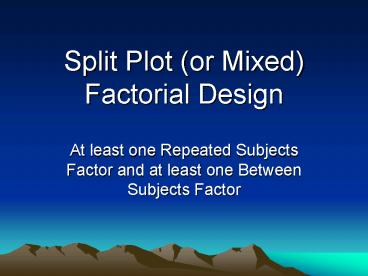Split Plot or Mixed Factorial Design - PowerPoint PPT Presentation
1 / 45
Title:
Split Plot or Mixed Factorial Design
Description:
Suppose a perceptual psychologist is interested in age differences in task ... A 2(age) by 4( position) split plot ANOVA using the multivariate approach to ... – PowerPoint PPT presentation
Number of Views:1243
Avg rating:3.0/5.0
Title: Split Plot or Mixed Factorial Design
1
Split Plot (or Mixed) Factorial Design
- At least one Repeated Subjects Factor and at
least one Between Subjects Factor
2
Example
- Suppose a perceptual psychologist is interested
in age differences in task performance the
target letter is shown at the center of the
screen (0 degree), and off-center (4 degrees, 8,
and 12 degrees). Specifically, the researcher is
interested in determining whether older adults
respond differently than younger adults. The
researcher measures how long it takes each
participant to react to the different
presentations of the target letters.
3
Conceptualize the Design
- What are the independent variable?
- What are factors and levels?
- What is dependent variable?
- Draw box to represent experiment.
- How would you enter the data in SPSS Data Editor?
4
(No Transcript)
5
(No Transcript)
6
(No Transcript)
7
(No Transcript)
8
(No Transcript)
9
(No Transcript)
10
(No Transcript)
11
(No Transcript)
12
(No Transcript)
13
(No Transcript)
14
(No Transcript)
15
(No Transcript)
16
(No Transcript)
17
(No Transcript)
18
(No Transcript)
19
Results
- A 2(age) by 4( position) split plot ANOVA using
the multivariate approach to repeated measures on
reaction time resulted in a statistically
significant interaction (Wilks Lambda F (3, 10)
7.69, p.006).
20
(No Transcript)
21
(No Transcript)
22
Interaction
- A significant interaction is followed up with
test of simple effects. You can either do
repeated measures factor within the between
subjects levels (aka like a one-way repeated
measures design) or the between subjects factor
within each level of repeated measures (Like a
oneway between subjects design)
23
For this Example
- Makes sense to compare differences in location of
stimuli (0, 4, 8, 12 degrees) for younger
adults and then for older adults. So Test of
simple effects of degree within age.
24
Trick
- Cant do this test of simple effects the way you
did when both factors were between subjects. You
need to do it differently
25
Step 1
- Get the computer to see only the younger adults.
- Under Data choose Select Cases
26
(No Transcript)
27
(No Transcript)
28
(No Transcript)
29
(No Transcript)
30
(No Transcript)
31
Now run a oneway repeated measures
32
(No Transcript)
33
(No Transcript)
34
Use Bonferroni correction of .05/2.025
35
Now need to repeat with age1
36
(No Transcript)
37
(No Transcript)
38
(No Transcript)
39
(No Transcript)
40
(No Transcript)
41
(No Transcript)
42
Use Bonferroni correction of .05/2.025
43
Results Continued
- Simple effect tests of degree within age using a
Bonferroni correction of .05/2.025 showed a
significant difference in reaction time among the
4 positions for younger adults (Wilks Lambda F(
3,4)20.49, p.007) but not older adults.
44
Homework
- Computer Project 2
45
Other homework
- Hinkle p. 441-442 7 only now the same people are
tested at each time period (use SPSS to conduct
omnibus test)































